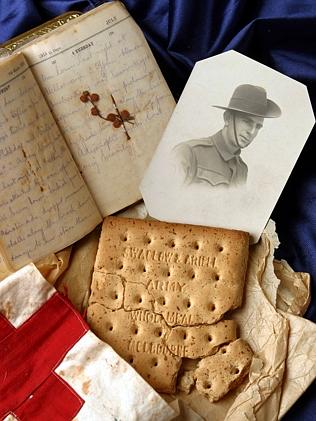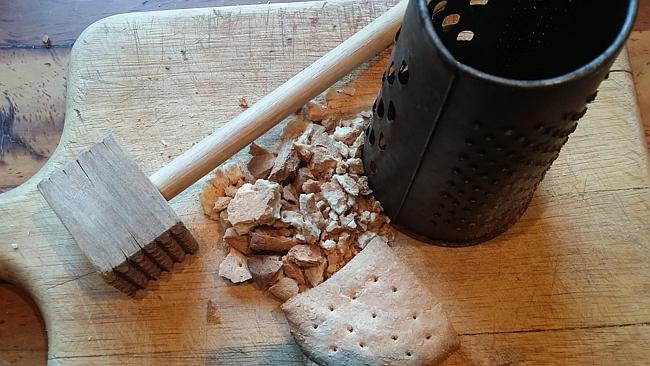Tough Bickies: The Original Anzac
What was the original Anzac made of? The biscuit, that is, not the soldier.
If you go to the Australian War Memorial in Canberra and hunt around in the research centre you’ll find it described as an army biscuit or Anzac wafer or Anzac tile. This version was a hardtack or long shelf-life biscuit used as a substitute for bread. It was made from flour, sugar, milk powder, salt and water. Rolled oats, coconut and golden syrup are all absent.
Unlike bread, however, the biscuits are very very hard. Some soldiers found them more palatable if they ground them up and used them as porridge.

A recipe supplied by Frank Townsend, former chief chemist at Arnotts Biscuits, points out that after rolling and pressing and cutting into squares, the biscuits were “docked: with a flat-ended pin or rod.
“Each biscuit should have five vertical and five horizontal rows of docker holes, 25 holes in all,” says Townsend. “There are those at the war memorial who argue for 49 (7×7) as the authentic number.”
Looking at the illustration which accompanied the recipe he sent me, they reminded me of Vita Weats. They sure don’t like the Anzacs I bake at home.
Another recipe, provided by Bob Lawson, an Anzac present at the Gallipoli landing, gives a more popular version and includes rolled oats, coconut and golden syrup. In One Continuous Picnic:A History of Australian Eating, Michael Symons says that this version was in recipe books by 1925.

Certainly there are countless variations (a 1945 version is kneaded like bread and called parkin or cocky’s joy) and some have suggested it was an adaptation of traditional Yorkshire biscuits called Parkin.
Anzac biscuits made with rolled oats, coconut and golden syrup are great for morning or afternoon tea and just the thing to add the children’s lunch box. Like the original army biscuits, they should be stored in an air-tight container.
For most of us Anzac Day is a leisurely day off, a day on which we can catch up with family and friends. Why not make the most of it and invite them for afternoon tea? Set the scene with a batch of freshly baked Pumpkin Scones, a homemade Blowaway Sponge and a plateful of Anzac biscuits.
Instead of the bully beef (tinned corned beef) the soldiers had to resort to, make potted meat sandwiches and present them on an elegant platter interspersed with sprigs of rosemary.
Don’t forget the tea. Tea was an important part of the rations for troops and was granted as an extra to soldiers on the peninsula. Use freshly boiled water but don’t overboil it. Remember to heat the teapot beforehand by rinsing with boiling water and once brewed, don’t let the leaves stew.
And for a 21st century version of Anzacs, why not make a batch of of these Fair Dinkum Anzacs or these fun, colourful Anzac Choc Pops with the kids on the day?

Anzac Paddle Pops Photo by Andrew Payne, Photographix
